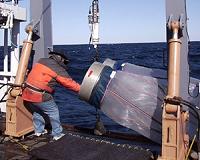| . |  |
. |
Narragansett RI (SPX) Mar 04, 2010 February 24, 2010 - Scientists at the University of Rhode Island are gaining new insight into the mechanisms that generate huge, steep underwater waves that occur between layers of warm and cold water in coastal regions of the world's oceans. David Farmer, a physical oceanographer and dean of the URI Graduate School of Oceanography, together with student Qiang Li, said that large amplitude, nonlinear internal waves can reach heights of 150 meters or more in the South China Sea, and the effects they have on surface wave fields ensure that they are readily observable from space. Farmer and Li will report results of their research at the Ocean Sciences Meeting of the American Geophysical Union in Portland, Ore.. "The large waves in the South China Sea have attracted a fair bit of attention in recent years," Farmer said, "but much of this has been directed at the interaction of the waves with the sloping continental shelf of mainland China where they break, overturn and produce intense mixing. Our focus is on the way in which they are generated in Luzon Strait, between Taiwan and the Philippines, and the way they evolve as they propagate westwards across the deep ocean basin of the South China Sea." Farmer and Li studied the evolution of large internal waves occurring at tidal periods generated by currents traversing submarine ridges in Luzon Strait. As these waves travel west through the South China Sea, they steepen and evolve into packets of steep, energetic waves occurring at periods of 20-30 minutes. It is these energetic short period waves that modulate the ocean surface roughness, making their presence observable from satellites in space. The URI scientists' observations showed that the Earth's rotation modifies internal waves as they travel cross the deep basin. This effect mainly influences the internal waves that form on the 24-hour period of diurnal tides, dispersing the energy and inhibiting the steepening process. Internal waves that form on the semi-diurnal tides are not affected in this way, are more readily steepened and then break into the energetic, short period waves. Farmer and Li studied internal waves in the South China Sea using pressure equipped inverted echo-sounders, instruments developed by scientists at the University of Rhode Island. From the seafloor, the device transmits an acoustic pulse and then listens for the echo from the sea surface. Sound travels faster through warm water than it does through cold water, so changes in the echo delay allow measurement of the thickness of the warm surface layer, enabling the shape and size of passing internal waves to be recorded. According to Farmer, nonlinear internal waves impact the ocean in many ways: stirring up sediment on the sea floor, creating hazards to offshore engineering structures, interfering with submarine navigation, and greatly affecting propagation of underwater sound. Internal waves also appear to have significant, if not fully understood, biological impacts, and in shallow water environments they can mix water masses and modify coastal circulation.
Share This Article With Planet Earth
Related Links University of Rhode Island Water News - Science, Technology and Politics
 Researchers Measure Impacts Of Changing Climate On Ocean Biology
Researchers Measure Impacts Of Changing Climate On Ocean BiologyWoods Hole MA (SPX) Mar 02, 2010 A three-year field program now underway is measuring carbon distributions and primary productivity in the Northwest Atlantic Ocean to help scientists worldwide determine the impacts of a changing climate on ocean biology and biogeochemistry. The study, Climate Variability on the East Coast (CliVEC), will also help validate ocean color satellite measurements and refine biogeochemistry models of o ... read more |
|
| The content herein, unless otherwise known to be public domain, are Copyright 1995-2010 - SpaceDaily. AFP and UPI Wire Stories are copyright Agence France-Presse and United Press International. ESA Portal Reports are copyright European Space Agency. All NASA sourced material is public domain. Additional copyrights may apply in whole or part to other bona fide parties. Advertising does not imply endorsement,agreement or approval of any opinions, statements or information provided by SpaceDaily on any Web page published or hosted by SpaceDaily. Privacy Statement |